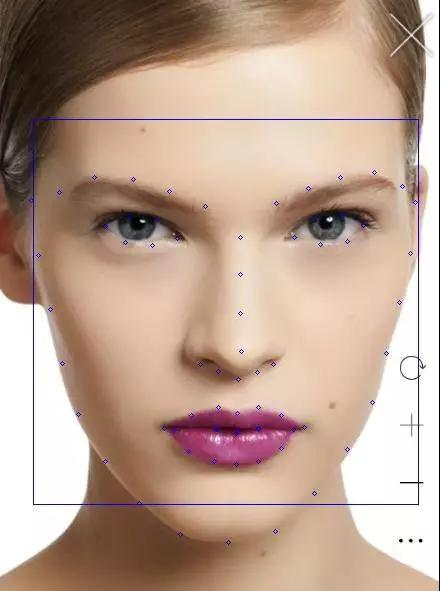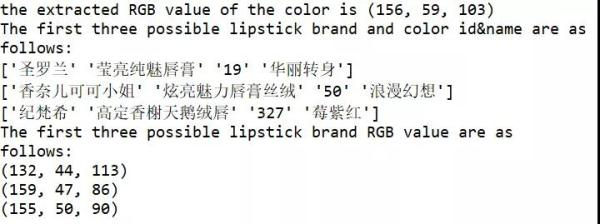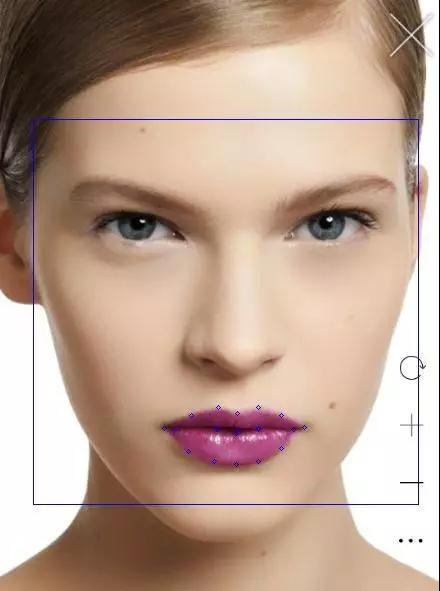MeanC=((int)(Mean_R/count),(int)(Mean_G/count),(int)(Mean_B/count))
return Me
番茄的颜色提取到了,那么和什么做比对呢?
当然是口红的数据,文摘菌这儿用到了 5 个品牌,分别是圣罗兰、香奈儿可可小姐、迪奥、美宝莲、纪梵希,共 17 个系列,271 个口红色号。
数据集是一个嵌套的字典数据结构,存为 json 串的形式,里面记录了每个口红品牌系列下不同口红色号的颜色 id、名称、和 16 进制颜色值。
lipstick.json部分数据集展示如下:
{“brands”:[{“name”:“圣罗兰”,“series”:
[{“name”:“莹亮纯魅唇膏”,“lipsticks”:
[{“color”:"#D62352",“id”:“49”,“name”:“撩骚”},
{“color”:"#DC4B41",“id”:“14”,“name”:“一见倾心”},
{“color”:"#B22146",“id”:“05”,“name”:“浮生若梦”},
数据集中存储的 RGB 颜色是 16 进制的字符串形式,需要将其转换成 RGB 值,比较两个颜色相近与否。
实际上是比较 RGB 三个分量维度上的误差,最小的口红输出对应的品牌、系列、色号和 id。
代码如下:
import json
import getcolor
import numpy as np
import lipcolor
#filename = ‘temp.txt’
##write the temp data to file##
def WtoFile(filename,RGB_temp):
num=len(RGB_temp)
with open(filename,‘w’) as f:
for i in range(num):
s = str(RGB_temp[i]).replace(’[’,’’).replace(’]’,’’)
f.write(s)
f.write("\n")
#operate the data #
##save the brand&series&color id&color name to sum_list##
##covert the color #D62352 to RGB_array##
##caculate the RGB difference to RGB_temp and write the value to file##
def data_operate():
with open(‘lipstick.json’, ‘r’, encoding=‘utf-8’) as f:
ret_dic = json.load(f)
#print(ret_dic[‘brands’])
#print(type(ret_dic)) #
#print(ret_dic[‘brands’][0][‘name’])
b_num=len(ret_dic[‘brands’])
#print(b_num)#brands number
s_list=[]
#series brands#
for i in range(len(ret_dic[‘brands’])):
s_num=len(ret_dic[‘brands’][i][‘series’])
s_list.append(s_num)
#print("{0} has {1} series".format((ret_dic[‘brands’][i][‘name’]),(s_list[i])))
#the lipstick color of every brands every series#
#the first loop calculate the total color numbers
sum=0
for b1 in range(b_num):
for s1 in range(s_list[b1]):
brand_name=ret_dic[‘brands’][b1][‘name’]
lip_name=ret_dic[‘brands’][b1][‘series’][s1][‘name’]
color_num=len(ret_dic[‘brands’][b1][‘series’][s1][‘lipsticks’])
sum+=color_num#calculate the total color numbers
#the second loop save the message to a list#
sum_list=np.zeros((sum,4), dtype=(str,8))
value_array=np.zeros((sum,6), dtype=int)
i=0
for b2 in range(b_num):
for s2 in range(s_list[b2]):
brand_name=ret_dic[‘brands’][b2][‘name’]
#print(type(brand_name))
lip_name=ret_dic[‘brands’][b2][‘series’][s2][‘name’]
color_num=len(ret_dic[‘brands’][b2][‘series’][s2][‘lipsticks’])
for c in range(color_num):
color_value=ret_dic[‘brands’][b2][‘series’][s2][‘lipsticks’][c][‘color’]
color_name=ret_dic[‘brands’][b2][‘series’][s2][‘lipsticks’][c][‘name’]
color_id=ret_dic[‘brands’][b2][‘series’][s2][‘lipsticks’][c][‘id’]
#print("{0} series {1} has {2} colors,color {3}:{4}".format(brand_name,lip_name,color_num,c+1,color_name))
sum_list[i][0]=brand_name
sum_list[i][1]=lip_name
sum_list[i][2]=color_id
sum_list[i][3]=color_name
#value_array[i]=value_array[i][1]
#convert “#D62352” to [13 6 2 3 5 2]#
for l in range(6):
temp=color_value[l+1]
if(temp>=&#39;A’and temp<=‘F’):
temp1=ord(temp)-ord(‘A’)+10
else:
temp1=ord(temp)-ord(‘0’)
value_array[i][l]=temp1
i+=1
#the third loop covert value_array to RGB_array#
RGB_array=np.zeros((sum,3), dtype=int)
for i in range(sum):
RGB_array[i][0]=value_array[i][0]*16+value_array[i][1]
RGB_array[i][1]=value_array[i][2]*16+value_array[i][3]
RGB_array[i][2]=value_array[i][4]*16+value_array[i][5]
#calculate the similar and save to RGB_temp
#RGB_temp=np.zeros((sum,1), dtype=int)
RGB_temp=np.zeros((sum,1), dtype=float)
for i in range(sum):
R=RGB_array[i][0]
G=RGB_array[i][1]
B=RGB_array[i][2]
RGB_temp[i]=abs(get[0]-R)+abs(get[1]*3/4-G)+abs(get[2]-B)
RGB_temp.tolist();#covert array to list
#print(RGB_temp)
filename=“temp.txt”
WtoFile(filename,RGB_temp)
#sort the RGB_temp#
result=sorted(range(len(RGB_temp)), key=lambda k: RGB_temp[k])
#print(result)
#output the three max prob of the lipsticks#
print(“The first three possible lipstick brand and color id&name are as follows:”)
for i in range(3):
idex=result[i]
print(sum_list[idex])
print(“The first three possible lipstick brand RGB value are as follows:”)
for i in range(3):
idex=result[i]
R=RGB_array[idex][0]
G=RGB_array[idex][1]
B=RGB_array[idex][2]
tuple=(R,G,B)
print(tuple)
if name == ‘main’:
#image = getcolor.Image.open(inputpath)
#image = image.convert(‘RGB’)
#get=getcolor.get_dominant_color(image)#tuple #get=(231, 213, 211)
list=[]
color_dir=“output”
count=lipcolor.load_color(color_dir,list)
get=lipcolor.Mean_color(count,list)
print(“the extracted RGB value of the color is {0}”.format(get))
#operate the data#
data_operat
输出最有可能吻合番茄颜色的前三个口红的信息,然后在 Spyder 中的运行结果:

可以看到最有可能的三个口红品牌色号的 RGB 值与番茄的 RGB 值是非常接近的。
提取到的番茄颜色:

‘迪奥’ ‘烈艳蓝金唇膏’ ‘080’ &#39;微笑正红’的颜色:

‘圣罗兰’ ‘纯口红’ ‘56’ &#39;橙红织锦’的颜色:

‘纪梵希’ ‘高定香榭天鹅绒唇’ ‘325’ &#39;圣水红’的颜色:

我已经眼花缭乱,三个颜色……有区别吗?!以后不如准备统一叫它们,番茄色!

不过,这也正说明了,刚刚的提取&对比方法可行!
既然可以识别番茄的颜色,那么,可以识别人像中的口红色号吗?
#####进入正题!人像口红色号识别
接下来,我们需要做的是输入一张人像图片,可以自动识别其中的嘴唇区域,并提取出嘴唇区域中的一部分做为颜色提取的源图像。
这里就要用到 CV 的人脸识别了,还好 Dlib 库又帮助我们减轻一大部分的工作量。
Dlib 中有自带的 68 个人脸的识别器,可以得到人脸部位包括眉毛、眼睛、鼻梁、面部轮廓和嘴唇区域的具体点的位置,到这儿,我以为很轻松就可以截到嘴唇区域了,结果有点尴尬…
我们首
《Android学习笔记总结+最新移动架构视频+大厂安卓面试真题+项目实战源码讲义》
【docs.qq.com/doc/DSkNLaERkbnFoS0ZF】 完整内容开源分享
先找到了一张小姐姐的照片:

截取到的嘴唇区域如下:

很明显的看到上下嘴唇黑色的区域也截取到了,这对后续的提色有影响,所以不得不回到最初的 68 个检测点来思考人生。

标记的 68 个人脸检测点如上图所示,而嘴唇部位是从第 49 个标记点开始的(数组的话,下标是 48)。
为了尽可能的截取到均匀成色的嘴唇片段,刚开始是想从第 50 个标记点对角线截取到第 56 个标记点,而这不可避免的会截取到上下嘴唇之间的缝隙,这儿的阴影也会影响后续的颜色提取准确度。
考虑到下嘴唇比上嘴唇宽,所以截取到下嘴唇中间的两个小正方形区域:


人脸识别和截取嘴唇区域的代码如下:
import numpy as np
import cv2
import dlib
from PIL import Image
def crop(source,pos):
x1=pos[2][0]
y1=pos[2][1]
x2=pos[1][0]
y2=pos[1][1]
d=abs(x2-x1)
region = source[(int)(y1-d*0.75):y2,x1:x2]
cv2.imwrite(“output/Mouth1.jpg”, region)
x1=pos[1][0]
y1=pos[1][1]
x2=pos[0][0]
y2=pos[0][1]
d=abs(x1-x2)
region = source[y1-d:y2,x1:x2]
cv2.imwrite(“output/Mouth2.jpg”, region)
def detect_mouth(img,pos):
gray = cv2.cvtColor(img, cv2.COLOR_BGR2GRAY)
gray = cv2.equalizeHist(gray)
detector = dlib.get_frontal_face_detector()
#use the predictor
predictor = dlib.shape_predictor(‘shape_predictor_68_face_landmarks.dat’)
dets = detector(img, 1)
print(“Number of faces detected: {}”.format(len(dets)))
for a in dets:
cv2.rectangle(img,(a.left(),a.top()),(a.right(),a.bottom()),(255,0,0))
#point_list=[]#save the mouth point to point_list[]#
#Extract 68 feature points of the face and crop the lip image#
for index, face in enumerate(dets):
print(‘face {}; left {}; top {}; right {}; bottom {}’.format(index, face.left(), face.top(), face.right(), face.bottom()))
shape = predictor(gray, face)
for i, pt in enumerate(shape.parts()):
#print(‘Part {}: {}’.format(i, pt))
#print(i)
pt_pos = (pt.x, pt.y)
if i>=48 and i<=67:
cv2.circle(img, pt_pos, 2, (255, 0, 0), 1)
if i>=56 and i<=58:
#print(pt_pos)
pos[i-56][0]=pt.x
pos[i-56][1]=pt.y
#cv2.circle(img, pt_pos, 2, (255, 0, 0), 1)
return img
if name == “main”:
img = cv2.imread(“test3.png”)
#copy the input image for the later crop#
img_clOne= np.copy(img)
cv2.imwrite(“input/source.jpg”,img_clone)
#save the lip position to pos array#
pos=np.zeros((3,2), dtype=int)
result=detect_mouth(img,pos)
cv2.imwrite(“input/source2.jpg”,result)
#crop the lip areas#
source = cv2.imread(“input/source.jpg”)
crop(source,pos)
cv2.imshow(‘FaceDetect’,result)
cv2.waitKey(0)
cv2.destroyAllWindow
既然已经截取到嘴唇的小矩形图像了,接下来的工作就和前面一样了,在数据库中对比每个 RGB 值输出最小误差对应的口红信息,而这儿也有难到我。
单纯的比对 RGB 分量对口红色号来说并不适用,有可能每个分量相差很小,而叠加起来的颜色和提取到的颜色并不相似,在颜色的比对上需要手动调参。
几经波折,最后输出的结果还是可以接受的,上图人像中涂的口红色号,感兴趣的读者可以查下正好是下面输出排名第一的口红信息。

#####误差分析

对于我们测试的图片信息,标记了嘴唇区域的特征点,我们提取到的 RGB 值(156,59,103)颜色如下所示:

可以看到和图片的颜色已经十分接近了,而数据集合 lipstick.json 中这种口红存储的 16 进制颜色值为 #842C71,对应的颜色如下:

明显看到数据集存储的颜色和实际照片的颜色是有些许误差的,而在本文算法实现过程中,又不可避免的有以下误差:
以上种种,使得让计算机快速高效地识别不同的口红色号还是有困难的,原来计算机有时候也会很直男。
#####实时人像口红色号预测
看到这儿,可能很多读者朋友想实时地试一下能不能让计算机判断自己的口红色号,这对于 OpenCV 这一强大的图形操作库来说,不是什么问题。
它可以打开你的摄像头,读取每一帧的图片,结合前文提到的人脸识别代码,可以实时地截取到嘴唇区域的图片,然后交给计算机预测,从此再也不怕女朋友的灵魂拷问!

最后,附上打开摄像头的代码,快叫女朋友过来试下吧!
#coding=utf8
import cv2
import time
print(‘Press Esc to exit’)
imgWindow = cv2.namedWindow(‘FaceDetect’, cv2.WINDOW_NORMAL)
import sys
import os
import dlib
import glob
import numpy
from skimage import io
def detect_face():
capInput = cv2.VideoCapture(0)
#nextCaptureTime = time.time()
faces = []
feas = []
if not capInput.isOpened(): print(‘Capture failed because of camera’)
while 1:
ret, img = capInput.read()
gray = cv2.cvtColor(img, cv2.COLOR_BGR2GRAY)
gray = cv2.equalizeHist(gray)
time=0
eTime = time.time() + 0.1
detector = dlib.get_frontal_face_detector()
predictor = dlib.shape_predictor(‘shape_predictor_68_face_landmarks.dat’)
dets = detector(gray, 1)
print(“Number of faces detected: {}”.format(len(dets)))
for a in dets:
cv2.rectangle(img,(a.left(),a.top()),(a.right(),a.bottom()),(255,0,0))
for index, face in enumerate(dets):
print(‘face {}; left {}; top {}; right {}; bottom {}’.format(index, face.left(), face.top(), face.right(), face.bottom()))
shape = predictor(gray, face)
(“Number of faces detected: {}”.format(len(dets)))
for a in dets:
cv2.rectangle(img,(a.left(),a.top()),(a.right(),a.bottom()),(255,0,0))
for index, face in enumerate(dets):
print(‘face {}; left {}; top {}; right {}; bottom {}’.format(index, face.left(), face.top(), face.right(), face.bottom()))
shape = predictor(gray, face)

 京公网安备 11010802041100号 | 京ICP备19059560号-4 | PHP1.CN 第一PHP社区 版权所有
京公网安备 11010802041100号 | 京ICP备19059560号-4 | PHP1.CN 第一PHP社区 版权所有